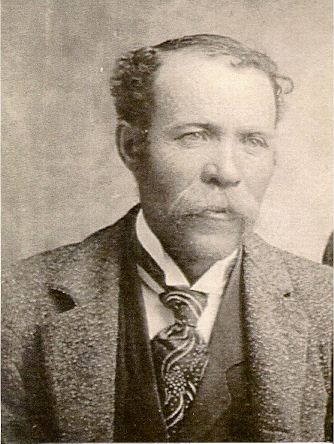As a result of the early morning shooting, Frazier faced charges of “assault with the intent to kill.” His trial was scheduled for May. The prosecution was led by County Attorney Allen and Hon. Ed Madison, “the famous young criminal lawyer of Dodge City”. Defending Frazier were two well-known Harvey County attorneys, Hon. Harry Bowman and Hon. Charles Bucher, “the king of criminal lawyers of Kansas”.
 |
Charles Bucher***
Photo courtesy Bob Myers, Newton City Attorney |
During the two day trial, witnesses for both men described a strained relationship which had started in June 1896. Each had tried to discredit the other man’s establishment. Dr. C.E. Johnson recalled a time when he was eating dinner at Frazier’s Hotel when Dickerson “had solicited him and accused Frazier’s place of being a dirty hole.” One friend of Dickerson, Dr. Winn, was heard to say “that Frazier ought to be hung and he would like to be the man to tie the know.”
Frazier took the stand and the Newton Kansan dramatically reported his testimony.
“The guest had gone into the hotel office and that he and Dickerson had remained outside, Frazier shutting the office door, the counsel asked dramatically, ‘Why didn’t you go in and take care of your guest, instead of remaining on the outside with the man you claim to be afraid of?’ Frazier was almost trapped and trembled perceptibly. After a pause, he answered: ‘I had a right to be on the sidewalk.'”
Frazier continued and “admitted that he did not see Dickerson have a weapon, or aim a weapon at any point in the affair.”
The trial lasted two days and was given to the jury on Tuesday night. Wednesday morning the verdict came back “guilty of assault with attempt to commit manslaughter.” Frazier faced up to 5 years of hard labor or more than six months in the County Jail.
Following the verdict
It could not be determined if Frazier served time for the shooting or not. The 1900 Census indicates that Amos Frazier was living in Newton; however, by 1910 he was back in Sedgwick. His wife Mary, died in 1928 and soon after Frazier moved to Wichita to live with his daughter, Bessie Hobble. He died in 1934 at the age of 87.
Charles Dickerson apparently moved on, perhaps back to Wichita. A brief note in the personal section of the Sedgwick Pantagraph noted that “Charles Dickerson will sell his household goods a public auction at his residence on north Commercial today.”
 |
| Sedgwick Pantagraph, 20 May 1897, p.1 |
No further information could be found on Charles Dickerson.
Perhaps the Sedgwick Pantagraph said it best:
“And so ends the last chapter of this lamentable affair in which all parties have doubtless been at fault, and all parties concerned have likewise suffered much. Let this case stand as a warning to all who may be concerned in annoying business complications or petty jealous rivalry. When the hot blood of passion mounts . . . beware, for the end is not there and the wake of thoughtless action often come the deepest sorrow.”(Sedgwick Pantagraph, 13 May 1897, p. 1)
Notes:
**The Wichita Eagle indicates that there was one passenger. Both the Sedgwick Pantagraph and the Newton Kansan indicated two.
***Charles Bucher practiced law with Cyrus Bowman, “the patriarch of the bar association” in Harvey County at the firm known as “Bowman & Bucher.” Bucher was a highly regarded attorney and involved in other high profile Harvey County cases in the 1890s, including the case featured by Bob Myers in his Speaker’s Bureau Program, “Harvey Counties Foulest Crime and Greatest Legal Battle”. By 1904/05, Bucher had moved away from Newton and was practicing in Bartlesville, OK. He then moved to Coffeyville, KS, where he spent the remainder of his life.
Sources:
- Sedgwick Pantagraph, July 11, 1895, November 28, 1895, April 23, 1896, April 30, 1896, March 11, 1897, March 25, 1897, April 1, 1897, April 22, 1897, May 13, 1897, May 20, 1897.
- Newton Kansan: March 11, 1897, May 13, 1897
- The May 13, 1897 issue contains the account of the entire trial.
- Wichita Daily Eagle: March 10, 1897
- United States Census 1880, 1900, 1910, 1920, 1930.
- Kansas Census 1885, 1895
- Find-a-Grave: Amos Frazier (1847-1934) Hillside Cemetery, Sedgwick, Harvey County, Kansas.
- Bob Myers to Kristine Schmucker via e-mail 7 November 2013 regarding Attorney Charles Bucher.





















I really appreciate sharing this great post. I like this blog and have bookmarked it. Thumbs up
Great,great, granddaughter of Amos. I just discovered Amos Frazier’s obituary. It stated that he was a man of kindly, jovial disposition a good neighbor and friend. In his later years he served as night marshal of Sedgwick. I enjoyed learning another side of his character.